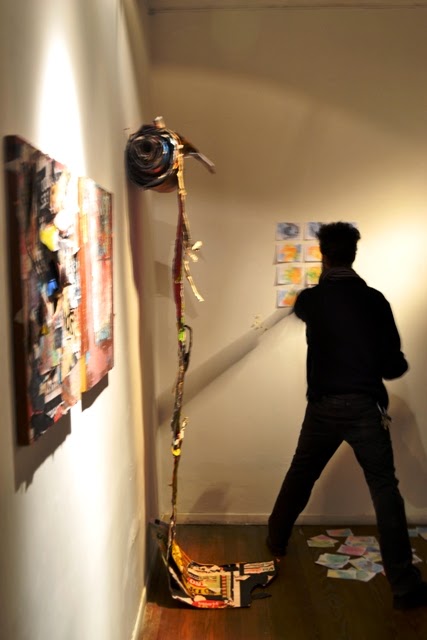Banchy Escapó de La Isla
Se suelen utilizar
varios términos para etiquetar al ser que se traslada por lugares distintos de
sus líneas limítrofes "asignadas". Mochilero,
turista, nómade, viajero, punk, etc. Todas estas expresiones son usadas muchas
veces en forma despectiva. Cada continente parece construir un sistema
masivo de visitantes frecuentes en lugares que tienden a recibirlos con
abundancia. Tienen sus mapas, las empresas de micros, hostels, hoteles,
actividades, paquetes de “todo preparado para usted como un viajero”. Las
relaciones entre viajeros y locales han progresado o disminuido en
función de la latitud y la longitud.
La gente viaja y emigra por
muchas razones diferentes. El Sudeste Asiático, se ve favorecido (por lo que he
presenciado) por una demografía con distancias muy amplias. Personas de
todas las edades y nacionalidades lo visitan el por diversos motivos. Hay
buscadores del alma, los que van por sus certificados en yoga, buceo, trapecio,
etc., los que intentan abrir un negocio, los sicarios, los exploradores de el
amor, los fetiches sexuales, las drogas, la emoción, los que intentan la foto
correcta para Instagram , y la lista sigue.
En el Sudeste Asiático los
nativos y expatriados han construido a través del tiempo un circuito para dar
cabida a las necesidades y deseos de todos los visitantes. Estos itinerarios
también se conectan a otros países: importación / exportación. Tienen palmeras
en el paraíso, escorpiones fritos, cocos, motos, todo a un precio de
dólares-euros- libras y más de lo que se pueda pagar. Más allá de todo lo que
pueda parecer a simple vista, la situación puede resultar al mismo tiempo
bastante siniestra. Todavía persiste ciertas veces un sentido de colonización y
aún existen jerarquías entre los visitantes. Entre ellos y también entre los
locales y extranjeros. Hay un lado oscuro de todo esto que puede ser bastante
extraño cómo se regenera en fases. El metal se utiliza para representar el
crecimiento industrial. Las ojotas son un símbolo universal del zapato.
Las cosas todavía pueden
fusionarse en círculos completos o triángulos. En medio de los buscadores del
alma y personas que pensaban que se estaban liberando a sí mismas, todavía hay
líneas construidas por este “circuito”. El Sudeste Asiático se utiliza aquí
como una influencia conceptual y estética debido a la cantidad de tiempo en que
he ahondado en sus profundidades y dinámicas sociales. La perspectiva
exhibida no se limita a esa parte del globo.
-------------------------------------------------------------------------------------------------------
Banchy Escaped The Island
There are various terms used to label a being who transports to locations
other than their “assigned” boundary lines if you will. Backpacker, tourist,
nomad, traveller, crust punk, etc. All of these terms can often times be used
derisively. Each continent seems to build a system for frequent masses of
visitors in locations that tend to receive them abundantly. So you’ve got your
maps, bus companies, hostels, hotels, activities, packages all set up for you
as a traveler. The relationships between travelers and locals have progressed
or digressed depending on the latitude and longitude.
People travel and migrate for so many different reasons. South East Asia
is favored from what I have witnessed, by the most wide ranged demographics.
People of all ages and nationalities visit South East Asia for different
reasons. Soul searching, certifications in yoga, scuba diving, trapeze etc.,
sex fetishes, a hitman, drugs, looking to open a business, love, thrill, the
right Instagram photo, and the list goes on.
Within South East Asia a circuit has been built over time by local
natives and expatriates to accommodate to all visitors’ needs and wants. These
circuits also connect to other countries, import /export. You’ve got palm trees
in paradise, fried scorpions, coconuts, motorbikes all at a price
dollars/euros/pounds can more than afford. Beyond all that meets the eye is
quite ominous at times. There is still a sense of colonization at times, and
hierarchies still exist amongst all visitors. Between themselves and between
locals and foreigners. There’s a dark side to it all that can be quite uncanny
how it regenerates in phases. Metal is used to represent industrial growth.
Flip flops are a symbol of the universal shoe.
Things can still meet in full circles or triangles. Amidst the soul
searchers and people who thought they were liberating themselves, there are
still lines built by this ‘circuit’. South East Asia is used as a conceptual
and aesthetical influence due to the amount of time I’ve had to penetrate into
the social depths and dynamics. The perspective exhibited is not limited to
that segment of the globe.






.jpg)




















